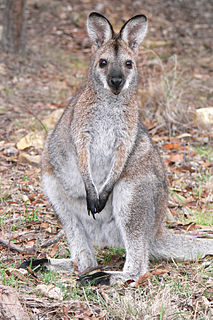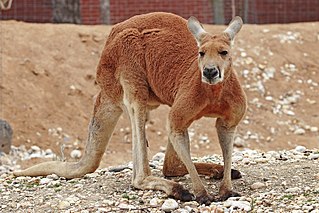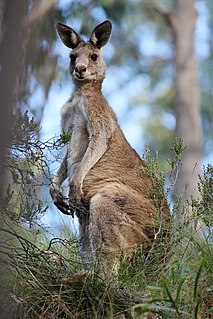
The kangaroo is a marsupial from the family Macropodidae. In common use the term is used to describe the largest species from this family, the red kangaroo, as well as the antilopine kangaroo, eastern grey kangaroo, and western grey kangaroo. Kangaroos are indigenous to Australia and New Guinea. The Australian government estimates that 34.3 million kangaroos lived within the commercial harvest areas of Australia in 2011, up from 25.1 million one year earlier.

A wallaby is a small or middle-sized macropod native to Australia and New Guinea, with introduced populations in New Zealand, Hawaii, the United Kingdom and other countries. They belong to the same taxonomic family as kangaroos and sometimes the same genus, but kangaroos are specifically categorised into the four largest species of the family. The term "wallaby" is an informal designation generally used for any macropod that is smaller than a kangaroo or a wallaroo that has not been designated otherwise.

Macropodidae is a family of marsupials, commonly known as kangaroos, wallabies, tree-kangaroos, wallaroos, pademelons, quokkas, and several other terms. These genera are allied to the suborder Macropodiformes, containing other macropods, and are native to the Australian continent, New Guinea and nearby islands.

The eastern grey kangaroo is a marsupial found in the eastern third of Australia, with a population of several million. It is also known as the great grey kangaroo and the forester kangaroo. Although a big eastern grey male typically weighs around 66 kg (146 lb) and stands almost 2 m tall, the scientific name, Macropus giganteus, is misleading: the red kangaroo of the semi-arid inland is larger, weighing up to 90 kg (200 lb).

The red kangaroo or red giant kangaroo is the largest of all kangaroos, the largest terrestrial mammal native to Australia, and the largest extant marsupial. It is found across mainland Australia, except for the more fertile areas, such as southern Western Australia, the eastern and southeastern coasts, and the rainforests along the northern coast.

The western grey kangaroo, also referred to as a western grey giant kangaroo, black-faced kangaroo, mallee kangaroo, and sooty kangaroo, is a large and very common kangaroo found across almost the entire southern part of Australia, from just south of Shark Bay through coastal Western Australia and South Australia, into western Victoria, and in the entire Murray–Darling basin in New South Wales and Queensland.
Wallaroo is a common name for several species of moderately large macropods, intermediate in size between the kangaroos and the wallabies. The word "wallaroo" is from the Dharug walaru. In general, a large, slim-bodied macropod of the open plains is called a "kangaroo"; a small to medium-sized one, particularly if it is relatively thick-set, is a "wallaby". Most wallaroos are only a little smaller than a kangaroo and a little bigger than a wallaby, fairly thick-set, and are found in open country. All share a particular habit of stance: wrists raised, elbows tucked close into the body, and shoulders thrown back, and all have a large, black-skinned rhinarium.

The tammar wallaby, also known as the dama wallaby or darma wallaby, is a small macropod native to South and Western Australia. Though its geographical range has been severely reduced since European colonization, the tammar wallaby remains common within its reduced range and is listed as "Least Concern" by the International Union for Conservation of Nature (IUCN). It has been introduced to New Zealand and reintroduced to some areas of Australia where it had been previously eradicated. Skull differences distinguish tammar wallabies from Western Australia, Kangaroo Island, and mainland South Australia, making them distinct population groups or possibly different subspecies.

Kangaroo meat is produced in Australia from wild kangaroos and is exported to over 60 overseas markets.

Macropus is a marsupial genus in the family Macropodidae. It has 13 extant species, which are divided into three subgenera. The genus includes four species of large terrestrial kangaroos, two species of wallaroos, and eight extant species of wallabies. The term is derived from the Ancient Greek μάκρος, makros "long" and πους, pous "foot". Thirteen known extinct species are recognised. The type species is the eastern grey kangaroo.
Grey kangaroo is a kangaroo that is gray.

The western brush wallaby, also known as the black-gloved wallaby, is a species of wallaby found in the southwestern coastal region of Western Australia. The wallaby's main threat is predation by the introduced red fox. The IUCN lists the western brush wallaby as Least Concern, as it remains fairly widespread and the population is believed to be stable or increasing, as a result of red fox control programs.

The antilopine kangaroo, also known as the antilopine wallaroo or the antilopine wallaby, is a species of macropod found in northern Australia: in Cape York Peninsula in Queensland, the Top End of the Northern Territory, and the Kimberley region of Western Australia. It is a locally common, gregarious grazer.

The black wallaroo, also known as Bernard's wallaroo or Woodward's wallaroo, is a species of macropod restricted to a small, mountainous area in Arnhem Land, Northern Territory, Australia, between South Alligator River and Nabarlek. It classified as near threatened, mostly due to its limited distribution. A large proportion of the range is protected by Kakadu National Park.

The common wallaroo, also known as the euro, hill wallaroo, or simply wallaroo is a species of macropod. The word euro is particularly applied to one subspecies.

Macropod hybrids are hybrids of animals within the family Macropodidae, which includes kangaroos and wallabies. Several macropod hybrids have been experimentally bred, including:

Boginderra Hills Nature Reserve is a protected nature reserve situated to the north of Temora, located in the Riverina region of New South Wales in eastern Australia. It has an area of 756 hectares.
Macropus pan is a species of marsupial that existed during the Pliocene in Australia, known only from fossils located at several sites across Australia. The species is recognised as allied to the modern grey kangaroos, the western Macropus fuliginosus and eastern Macropus giganteus, in a clade initially named as subgenus Macropus (Macropus) Dawson & Flannery. The first description was provided by Charles W. De Vis in 1895, emerging from the author's examination of fossil material held at the Queensland Museum. Fossil specimens of Quanbun local fauna, named for a site in Western Australia, were also identified as this species. The origin of the type specimen was not recorded, although based on comparisons to material with a known provenance it is assumed to have excavated at Chinchilla, Queensland. A larger macropod than any modern species, the standing height was estimated to be over two metres.















